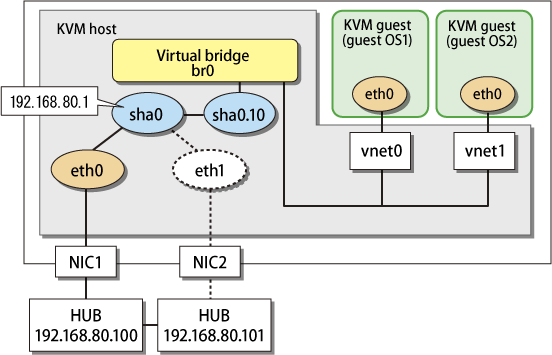This section describes a configuration setup example for the following network configuration.

1) Setting up the system
1-1) Define the IP addresses and host names you use in the /etc/hosts file.
192.168.80.1 hosta # virtual IP address of the KVM host 192.168.80.100 swhub1 # IP address of the primary monitoring destination's HUB 192.168.80.101 swhub2 # IP address of the secondary monitoring destination's HUB |
For RHEL8
1-2) Edit the /etc/sysconfig/network-scripts/ifcfg-ethX (X is 0, 1) files as follows.
Contents of /etc/sysconfig/network-scripts/ifcfg-eth0
TYPE=Ethernet BOOTPROTO=none DEVICE=eth0 ONBOOT=yes |
Contents of /etc/sysconfig/network-scripts/ifcfg-eth1
TYPE=Ethernet BOOTPROTO=none DEVICE=eth1 ONBOOT=yes |
For RHEL9
1-2) Set the following parameters to ethX (X is 0, 1) with the "nmcli connection modify" command.
ipv4.method: "disabled" ipv6.method: "disabled" connection.autoconnect: "yes" |
After setting, verify that the following parameters are set for ethX with the "nmcli connection show" command. If the parameters are different, fix the settings seeing "3.2.2.1 Setup common to modes."
connection.type: "802-3-ethernet" connection.id: "ethX" connection.interface-name: "ethX" |
2) Creating a virtual interface
/opt/FJSVhanet/usr/sbin/hanetconfig create -n sha0 -m v -t eth0,eth1
3) Setting the virtual bridge
For RHEL8
Create /etc/sysconfig/network-scripts/ifcfg-br0 as a new interface setup file for the virtual bridge.
Contents of /etc/sysconfig/network-scripts/ifcfg-br0
DEVICE=br0 TYPE=Bridge BOOTPROTO=none ONBOOT=yes DELAY=0 |
For RHEL9
Create br0 with the following parameters by using the "nmcli connection add" command.
connection.id: "br0" connection.interface-name: "br0" connection.type: "bridge" connection.autoconnect: "yes" ipv4.method: "disabled" ipv6.method: "disabled" |
4) Setting a virtual interface
For RHEL8
Define an IP address or a prefix in the /etc/sysconfig/network-scripts/ifcfg-sha0 file.
Contents of /etc/sysconfig/network-scripts/ifcfg-sha0
DEVICE=sha0 IPADDR=192.168.80.1 PREFIX=24 BOOTPROTO=none ONBOOT=yes TYPE=Ethernet |
For RHEL9
Set the following parameters to sha0 with the "nmcli connection modify" command.
connection.slave-type: "bridge" connection.master: "br0" ipv4.method: "manual" ipv4.addresses: "192.168.80.1/24" |
5) Adding a tagged VLAN interface
For RHEL8
To add the tagged VLAN interface sha0.10 on the virtual interface sha0, add the /etc/sysconfig/network-scripts/ifcfg-sha0.10 file. In addition, define the virtual bridge name (BRIDGE=br0) of the connection target.
Contents of /etc/sysconfig/network-scripts/ifcfg-sha0.10
VLAN=yes
TYPE=Vlan
PHYSDEV=sha0
VLAN_ID=10
BOOTPROTO=none
BRIDGE=br0 |
For RHEL9
Create sha0.10 with the following parameters by using the "nmcli connection add" command.
connection.id: "sha0.10" connection.interface-name: "sha0.10" connection.type: "vlan" connection.autoconnect: "yes" connection.slave-type: "bridge" connection.master: "br0" vlan.parent: "sha0" vlan.id: "10" ipv4.method: "disabled" ipv6.method: "disabled" |
6) Setting the network monitoring function
/opt/FJSVhanet/usr/sbin/hanetpathmon target -n sha0 -p 192.168.80.100,192.168.80.101
7) Setting /etc/NetworkManager/NetworkManager.conf
Describe the tagged VLAN interface, which is set in step 5), in /etc/NetworkManager/NetworkManager.conf.
Contents of /etc/NetworkManager/NetworkManager.conf
[main] ... ignore-carrier=sha0.10 |
Note
The setting of /etc/NetworkManager/NetworkManager.conf is required to control the processing of NetworkManager for tagged VLAN interfaces and manage the processing in GLS. Make sure to set /etc/NetworkManager/NetworkManager.conf.
8) Reboot
Run the following command to reboot the system.
/sbin/shutdown -r now